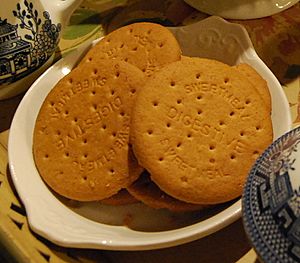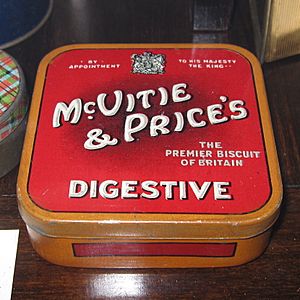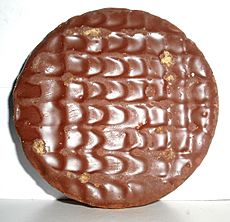Digestive biscuit facts for kids
 |
|
| Alternative names | Wheaten, sweet-meal biscuit |
|---|---|
| Type | Biscuit |
| Place of origin | Scotland |
| Region or state | Forres |
| Main ingredients | Wheat flour, sugar, malt extract, butter (or in cheaper recipes or for vegans or those who are lactose intolerant: vegetable oil), wholemeal, leavening agents (usually sodium bicarbonate, tartaric acid and malic acid), salt |
A digestive biscuit is a slightly sweet biscuit that first came from Scotland. It was created in 1839 by two Scottish doctors. They hoped it would help with digestion. The name "digestive" comes from the idea that these biscuits could help settle your stomach. This was because they used sodium bicarbonate, which is like a mild antacid.
Today, the McVitie's digestive is the most popular biscuit in the UK. It was first made in 1892. People in the UK love to "dunk" them in tea. In fact, about 6 million digestive biscuits are eaten every day in the UK! That's like 70 biscuits every second.
Contents
History of Digestive Biscuits

Digestive biscuits were invented in the United Kingdom in 1839. Two doctors in Scotland created them to help people digest their food better. These biscuits started appearing in advertisements for biscuit companies like Huntley & Palmers by 1876. Recipes for them were also shared in cookbooks.
In 1889, a man named John Montgomerie from Scotland got a patent in the U.S. for making "Malted Bread." This patent also included how to make digestive biscuits. He believed his method would create "nourishing food for people of weak digestion."
Even though some people think it's illegal to sell them in the United States under their usual name, you can actually find them there. They are often sold in special sections for imported foods or ordered online.
What's in a Digestive Biscuit?
A typical digestive biscuit has a few main ingredients. It usually contains coarse brown wheat flour. This flour gives the biscuit its special texture and taste. Other ingredients include sugar, malt extract, and vegetable oil.
They also contain wholemeal and raising agents. Raising agents are things like sodium bicarbonate, which help the biscuit rise and become light. A little salt is also added. Sometimes, other things like dried whey or oatmeal might be included.
One digestive biscuit usually has around 70 calories. This can change a little depending on how it's made.
How People Enjoy Digestive Biscuits
Digestive biscuits are often eaten with milk, tea, or coffee. Many people love to dunk their biscuit into their hot drink. You have to eat it quickly though, because digestives can get soft and break apart when wet! They are one of the most popular biscuits for dunking in the UK.
Digestive biscuits can also be used like crackers with cheese. You might even find them in cracker selection packs. In the UK, McVitie's digestives are the top-selling biscuit, with 80 million packs sold each year.
These biscuits are also great for cooking! They are often crushed up to make bases for cheesecakes and other yummy desserts.
Chocolate Digestives
Many people love chocolate digestives! These are regular digestive biscuits that have a layer of milk chocolate, dark chocolate, or white chocolate on the bottom. McVitie's first made them in 1925.
You can find different kinds of chocolate digestives. Some have chocolate "chips" mixed into the biscuit. Others might have a layer of caramel, mint chocolate, or orange-flavored chocolate. The famous American writer Bill Bryson once called the chocolate digestive "a British masterpiece." In 2009, the McVitie's chocolate digestive was named the most popular biscuit to dunk in tea in the UK.
Digestives in Pop Culture
Digestive biscuits have even appeared in famous stories and TV shows!
Fans of the rock band The Beatles might know about a time when McVitie's digestive biscuits caused a small argument. This happened between George Harrison and John Lennon while they were recording their 1969 album Abbey Road. The band's recording engineer, Geoff Emerick, wrote about it in his book. He said that John Lennon's wife, Yoko Ono, took some biscuits from George Harrison's box. This made George a bit upset, which led to a brief disagreement.
Chocolate digestives have also been a challenge on popular baking shows. They were a "technical challenge" for the bakers in series 3, episode 8 of The Great British Bake Off. They were also a challenge on episode 2, season 2 of The Great Canadian Baking Show.
Images for kids
See also
 In Spanish: Galleta digestiva para niños
In Spanish: Galleta digestiva para niños



